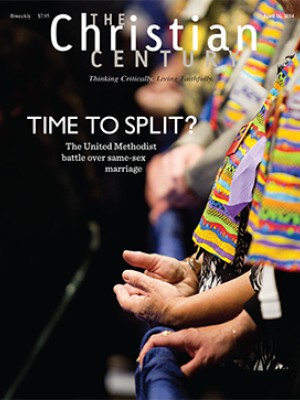Ways to be Lutheran: New churches experiment with polity

American Lutherans became a full part of American Protestantism just in time to participate in its decline. From its high of more than 9 million members in 1965, the total number of American Lutherans declined to just over 7 million in 2013, representing about 2 percent of the American population. Though Lutheran numbers generally plateaued through the 1970s and 1980s, both the Evangelical Lutheran Church in America and the Lutheran Church–Missouri Synod have declined markedly over the past 25 years. The ELCA went from 5.2 million members in 1988 to 3.9 million in 2013; the LCMS declined less severely, from 2.7 million members in 1988 to 2.3 million in 2013. The decline in giving to the national programs and offices of these two denominations is also fairly dramatic, though more pronounced in the ELCA.
Besides suffering from the same negative demographic trends facing other mainline Protestant denominations in this period—aging membership and an inability to retain younger members—the ELCA since 2000 has witnessed the departure of nearly 500,000 members who have coalesced into two new and distinct centrist Lutheran denominations: the Lutheran Congregations in Mission for Christ (2001) and the North American Lutheran Church (2010). Though the scale of these departures is noteworthy in itself, this development is all the more interesting for the new patterns and new directions that these denominations are attempting to develop. Their rejection of the ELCA (and implicitly the LCMS) has forced them to experiment with new ways of being Lutheran Christians in the American context, and they are actively exploring these possibilities.
Read our latest issue or browse back issues.
The older and larger of these two new denominations is the Lutheran Congregations in Mission for Christ, which had its beginnings in 2001 and now numbers more than 350,000 members in over 700 congregations in the United States. This group has its roots in the Lutherans who were troubled by the ecumenical agreement between the ELCA and the Episcopal Church in 1999, “Called to Common Mission.” Already disaffected within the ELCA, these Lutheran dissidents resisted the adoption of the agreement because they believed that it took the ELCA further in a centralized and clericalized direction. Losing this fight was the proverbial “last straw” for them, and many began the difficult and complicated process of formally leaving the ELCA.
As its name suggests, the Lutheran Congregations in Mission for Christ is a Lutheran experiment in congregational polity, historically something that Lutherans have rarely attempted to implement. The LCMC vests power solely in the local congregations and understands itself as advisory to them. This is more than problematic for many American Lutherans, who, though they often complain about “synod,” have come to rely on the support of a denominational body in times of need. Weaning pastors and congregations from this pattern and encouraging them to take their own responsibility has proven to be challenging. The leadership of the LCMC has been adamant about (sometimes even fixated on) not becoming just another Lutheran denomination, but rather continuing this experiment.
The congregations within the LCMC are not unified by a single theology or form of Lutheran practice, and many of them were already anomalies within the ELCA before they departed. There are a number of different wings or emphases within the LCMC—congregations whose ethos tends toward evangelical, charismatic, or low-church pietist expressions of Lutheranism—so the annual gatherings of the LCMC tend to be rather eclectic. This is mostly celebrated, but can cause frictions. Within the LCMC congregations are allowed (but not required) to join various Mission Districts; some of these groups represent geographical regions (as has been common in Lutheranism), but others are affiliation groups of congregations that share a common ethos, such as those listed above. An interesting example of such an affiliation grouping is one found in the upper Midwest, the Augustana District, which represents a creative move back toward some elements of the more typical synodical structure of mutual accountability between congregations. Though some others in the LCMC grumble about “creeping synodicalism,” the ethos of the LCMC itself allows congregations and districts their own autonomy, even to explore such directions.
The second new denomination, the North American Lutheran Church, was formed after the 2009 decision by the ELCA to allow the ordination of noncelibate homosexual pastors. Formally organized in 2010, this denomination has grown in just a few years to represent more than 125,000 members and 335 congregations in the United States and Canada. Although these dissident congregations could have joined the LCMC, those who eventually formed the NALC did not appreciate the congregational polity of the LCMC and sought to replicate a more traditional American Lutheran synodical polity. The NALC is strongest in the belt of Lutherans that runs from Pennsylvania through the lower Middle West to Iowa, down the East Coast to the Carolinas, and in Texas. Like the LCMC, the NALC has its own internal groupings, including a sizable number of Evangelical Catholic Lutherans with a liturgical and high-church orientation.
On its surface the NALC does not look like much of a radical departure from the ELCA; indeed, some of its critics call it “the ELCA without gays.” But this misses the point of the NALC itself, which seems actually to be a reappropriation of older American Lutheran patterns that had been wiped out in the waves of merger that led to the ELCA. A number of its innovations seem minor, but in reality are reversing 20th-century trends. The NALC has a different leadership pattern, with a single bishop in charge of the spiritual and pastoral aspects of the denomination, while a general secretary handles the day-to-day administration. Traditionally synodical in its polity, the NALC nevertheless revives an older Lutheran tradition wherein major decisions for the denomination are subject to congregational ratification (something the ELCA abandoned in its 1988 formation).
Both of these new Lutheran denominations face similar problems. They certainly face the potential of internal factionalism and external isolation. Both were born out of prolonged and difficult schism, and many of their congregations and pastors bear traumatic scars from taking leave of the ELCA. This makes internal bonds of trust more difficult to achieve, and critical points within the history of these two groups have been colored by such stress. They have grown, but mainly by drawing congregations and members out of the ELCA, which is not a long-term strategy for growth. It is difficult to determine whether the congregations of either denomination are successful in reaching the unchurched. Both denominations are underrepresented in growing suburban and exurban areas of the country. Only time will tell if these two new denominations will be able to embody this ethos of evangelism and outreach that they know they must achieve.
Nevertheless, these two denominations are interesting experiments in how American Protestantism might reinvent itself for the challenges of the 21st century. The two groups have structured themselves, almost instinctively, by drawing from successful historical patterns in American Lutheranism. What seems most striking about both of them is that they have been able to engender in their pastors and lay leaders a sense of identity, spirit, and common mission. They have flattened and minimized levels of structure and administration, decentralized authority, empowered their members, and allowed for experimentation and change. These changes seem to have developed a level of trust and identity within the denominations that has allowed them to move forward.
It is hardly fair to compare the experiences of large, established denominations such as the ELCA or the LCMS with those of much smaller, start-up denominations. Like many other older American Protestant denominations, the ELCA and LCMS have already undergone extensive changes in the past 20 years. But these changes have been, for the most part, incremental and involuntary—hundreds of small, reactive reductions that have attempted to “stop the bleeding” without really addressing the underlying problems. These reactive strategies are of limited use, and to suggest that such decline is inevitable is unacceptable. Imaginative reinvention of the kind undertaken by the LCMC and NALC could be the key to a better future for the ELCA and LCMS and might, in the long run, be well worth the struggle.





